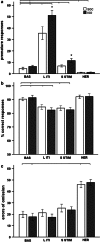Early social experience is critical for the development of cognitive control and dopamine modulation of prefrontal cortex function
- PMID: 23403694
- PMCID: PMC3682143
- DOI: 10.1038/npp.2013.47
Early social experience is critical for the development of cognitive control and dopamine modulation of prefrontal cortex function
Abstract
Social experiences during youth are thought to be critical for proper social and cognitive development. Conversely, social insults during development can cause long-lasting behavioral impairments and increase the vulnerability for psychopathology later in life. To investigate the importance of social experience during the juvenile and early adolescent stage for the development of cognitive control capacities, rats were socially isolated from postnatal day 21 to 42 followed by re-socialization until they reached adulthood. Subsequently, two behavioral dimensions of impulsivity (impulsive action in the five-choice serial reaction time task (5-CSRTT) and impulsive choice in the delayed reward task) and decision making (in the rat gambling task) were assessed. In a separate group of animals, long-lasting cellular and synaptic changes in adult medial prefrontal cortex (PFC) pyramidal neurons were determined following social isolation. Juvenile and early adolescent social isolation resulted in impairments in impulsive action and decision making under novel or challenging circumstances. Moreover, socially isolated rats had a reduced response to enhancement of dopaminergic neurotransmission (using amphetamine or GBR12909) in the 5-CSRTT under challenging conditions. Impulsive choice was not affected by social isolation. These behavioral deficits were accompanied by a loss of sensitivity to dopamine of pyramidal neurons in the medial PFC. Our data show long-lasting deleterious effects of early social isolation on cognitive control and its neural substrates. Alterations in prefrontal cognitive control mechanisms may contribute to the enhanced risk for psychiatric disorders induced by aberrations in the early social environment.
Figures





References
-
- Andersen SL. Trajectories of brain development: point of vulnerability or window of opportunity. Neurosci Biobehav Rev. 2003;27:3–18. - PubMed
-
- Bechara A, Damasio AR, Damasio H, Anderson SW. Insensitivity to future consequences following damage to human prefrontal cortex. Cognition. 1994;50:7–15. - PubMed
-
- Blakemore SJ. The social brain in adolescence. Nat Rev Neurosci. 2008;9:267–277. - PubMed
Publication types
MeSH terms
Substances
Grants and funding
LinkOut - more resources
Full Text Sources
Other Literature Sources
Miscellaneous

